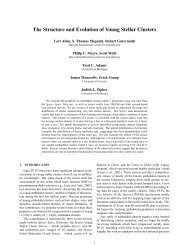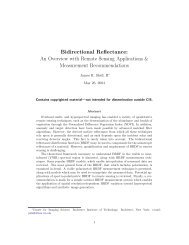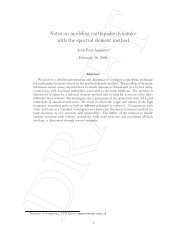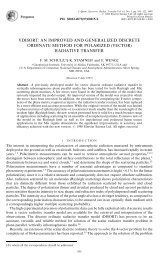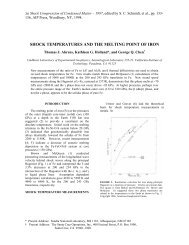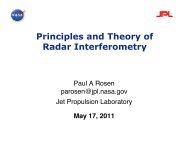Special note regarding Cox-Munk type ocean BRDF kernels:The Cox-Munk kernel uses σ 2 = 0.003 + 0.00512*W where W is the wind speed in meters/secondfor the first parameter. For example, if W = 10, then σ 2 = 0.054200. In contrast, the Giss-Cox-Munk kernel uses 0.5*σ 2 for the first parameter (half the value!). Thus, for this value of W, theGiss-Cox-Munk kernel would a value of 0.5*σ 2 = 0.027100 for its first parameter.Also, the Cox-Munk kernel uses the square of the refractive index for the second parameter. Forexample, if the refractive index is 1.334, then the second parameter would be 1.334*1.334 =1.779556. In contrast, the Giss-Cox-Munk kernel uses just the refractive index itself for thesecond parameter. Thus, the Giss-Cox-Munk kernel would a value of 1.334 for its secondparameter.Table F: File-read Character strings for linearized kernel variables in BRDF Supplement Table CName Kind Character string in Configuration fileDO_KERNEL_FACTOR_WFS LogicalDO_KERNEL_PARAMS_WFS LogicalKernels, indices, # pars, Factor Jacobian flag, Par Jacobian flagsThese quantities are formatted together for each kernel usingFormat (A10,I3,I2,4L). See example below.Example of linearized BRDF inputs: configuration file settings for 3 BRDFkernels as indicated:BRDFSUP - Kernels, indices, # pars, Factor Jacobian flag, Par Jacobian flagsCox-Munk 9 2 T T T FRoss-thin 2 0 T F F FLi-dense 5 2 T T T F6.3.4. Ocean glitter kernel functionWe now turn to descriptions of the individual BRDF kernels. The ocean glitter kernel isdescribed here and the land kernels in the following section. For glitter, we use the well-knowngeometric-optics regime for a single rough-surface redistribution of incident light, in which thereflection function is governed by Fresnel reflectance and takes the form [Jin et al., 2006]:2122ρ ( μ,μ′ , φ φ′, , σ ) ( θ , ). . ( γ , σ ). ( μ,μ′CM− m = rrm P D , σ )4 rμμ′γ. (6.3.5)r2Here, σ is the slope-squared variance (also known as the MSS or mean slope square) of the2Gaussian probability distribution function P ( γ , σ ) which has argument γ (the polar direction ofthe reflected beam); r( θ , m)is the Fresnel reflection for incident angle θ and relative refractive2index m, and ( μ , μ′2D , σ ) is a correction for shadowing. The two non-linear parameters are σand m. We have the usual Cox-Munk empirical relation [Cox and Munk, 1954a]:2σ = 0.003+0.00512W(6.3.6)in terms of the wind speed W in m/s. A typical value for m is 1.33. The MSS Gaussian is:112
22 1 ⎡ α ⎤P ( α,σ ) = exp⎢−22 2 ⎥ ; (6.3.7)πσ ⎣ σ (1 − α ) ⎦The shadow function of [Sancer, 1969] is widely used, and is given by:21D ( α,β , σ ) =221+ Λ ( α,σ ) + Λ(β , σ ); (6.3.8a)⎛21/ 22 ⎡ ⎤ ⎞2 1 ⎜ ⎡(1− α ) ⎤ σ ⎡ α ⎤αΛ ( α,σ ) =− ⎢ ⎥⎟⎜ ⎢ ⎥ exp⎢−⎥ erfc2 22⎟ . (6.3.8b)⎝ ⎣ π ⎦ α ⎣ σ (1 − α )2⎦ ⎢⎣σ (1 − α ) ⎥⎦⎠Both the Gaussian function and the shadow correction are fully differentiable with respect to the2defining parameters σ and m. Indeed, we have:222P(α,σ ) P(α,σ ) ⎡ α ⎤= ⎢ − σ242 ⎥ . (6.3.9)∂σσ ⎣(1− α ) ⎦∂ 2The shadow function can be differentiated in a straightforward manner since the derivative of the2error function is another Gaussian. The complete kernel derivative with respect to σ is then:∂ρCM2( μ,μ′, φ − φ′, m,σ )1= r(θ , ).2rm∂σμμ′γr4.22⎡∂P(γ∂ ′ ⎤r, σ )22 D(μ,μ , σ )⎢ . D(μ,μ′, σ ) + P(γ , σ ).2r2 ⎥⎣ ∂σ∂σ⎦(6.3.10)<strong>VLIDORT</strong> has a vector kernel function for sea-surface glitter reflectance, based on thedescription in [Mischenko and Travis, 1997]; this "GISS-COXMUNK" kernel has also beencompletely linearized with respect to the MSS [Natraj and Spurr, 2007].With this formulation of linearized input for the glitter kernel, LIDORT and <strong>VLIDORT</strong> are thusable to deliver analytic weighting functions with respect to the wind speed. This is important forremote sensing instruments with a glitter viewing mode; an example is the Orbiting CarbonObservatory [Crisp et al., 2004]. Note that it is possible to use other parameterizations of theMSS [Zhao and Toba, 2003] in this glitter formalism.The above formulation is for a single Fresnel reflectance by wave facets. In reality, glitter is theresult of many reflectances. Writing R(Ω,Ω 0 ) for the glitter BRDF for incident and reflecteddirections Ω 0 = {μ 0 ,φ 0 } and Ω = {μ,φ}, respectively, we have for one extra order of scattering:R Ω,Ω ) = R ( Ω,Ω ) + R ( Ω,) ; (6.3.11a)(0 0 0 1Ω02π1R ( Ω , Ω ) = ∫∫ R ( Ω,Ω′′) R ( Ω′′, Ω dμ′′dφ′′. (6.3.11b)1 000 0)00The azimuthal integration for the additional correction is done by double Gaussian quadratureover the intervals [−π,0] and [0,π]. The polar stream integration in (6.3.11b) is also done byGauss-Legendre quadrature. Both these equations are differentiable with respect to the slope-113
- Page 1:
User’s GuideVLIDORTVersion 2.6Rob
- Page 5 and 6:
Table of Contents1H1. Introduction
- Page 7 and 8:
1. Introduction to VLIDORT1.1. Hist
- Page 9 and 10:
Table 1.1 Major features of LIDORT
- Page 11 and 12:
In 2006, R. Spurr was invited to co
- Page 13:
corrections, and sphericity correct
- Page 16 and 17:
Matrix Π relates scattering and in
- Page 18 and 19:
m⎛ P⎞l( μ)0 0 0⎜⎟mmm ⎜ 0
- Page 20 and 21:
In the following sections, we suppr
- Page 22 and 23:
of the single scatter albedo ω and
- Page 24 and 25:
Here T n−1 is the solar beam tran
- Page 26 and 27:
~ + ~ ~ (1)~ ~ + ~ ~ (2)~ ~ − ~ 1
- Page 28 and 29:
The solution proceeds first by the
- Page 30 and 31:
Linearizations. Derivatives of all
- Page 32 and 33:
For the plane-parallel case, we hav
- Page 34 and 35:
One of the features of the above ou
- Page 36 and 37:
L↑↑ ↑k (cot n −cotn −1)[
- Page 38 and 39:
Note the use of the profile-column
- Page 40 and 41:
βl,aer(1)(2)fz1e1βl+ ( 1−f ) z2
- Page 42 and 43:
For BRDF input, it is necessary for
- Page 44 and 45:
streams were used in the half space
- Page 46 and 47:
anded tri-diagonal matrix A contain
- Page 48 and 49:
in place to aid with the LU-decompo
- Page 50 and 51:
In earlier versions of LIDORT and V
- Page 53 and 54:
4. The VLIDORT 2.6 package4.1. Over
- Page 55 and 56:
(discrete ordinates), so that dimen
- Page 57 and 58:
Table 4.2 Summary of VLIDORT I/O Ty
- Page 59 and 60:
Table 4.3. Module files in VLIDORT
- Page 61 and 62: Finally, modules vlidort_ls_correct
- Page 63 and 64: end program main_VLIDORT4.3.2. Conf
- Page 65 and 66: $(VLID_DEF_PATH)/vlidort_sup_brdf_d
- Page 67 and 68: Finally, the command to build the d
- Page 69 and 70: Here, “s” indicates you want to
- Page 71 and 72: The main difference between “vlid
- Page 73 and 74: to both VLIDORT and the given VSLEA
- Page 75 and 76: STATUS_INPUTREAD is equal to 4 (VLI
- Page 77 and 78: 5. ReferencesAnderson, E., Z. Bai,
- Page 79 and 80: Mishchenko, M.I., and L.D. Travis,
- Page 81: Stamnes K., S-C. Tsay, W. Wiscombe,
- Page 84 and 85: Table A2: Type Structure VLIDORT_Fi
- Page 86 and 87: DO_WRITE_FOURIER Logical (I) Flag f
- Page 88 and 89: USER_LEVELS (o) Real*8 (IO) Array o
- Page 90 and 91: angle s, Stokes parameter S, and di
- Page 92 and 93: DO_SLEAVE_WFS Logical (IO) Flag for
- Page 94 and 95: 6.1.1.8. VLIDORT linearized outputs
- Page 96 and 97: NFINELAYERS Integer Number of fine
- Page 98 and 99: 6.1.2.4. VLIDORT linearized modifie
- Page 100 and 101: The output file contains (for all 3
- Page 102 and 103: The first call is the baseline calc
- Page 104 and 105: for a 2-parameter Gamma-function si
- Page 106 and 107: Remark. In VLIDORT, the BRDF is a 4
- Page 108 and 109: 6.3.3.1. Input and output type stru
- Page 110 and 111: Table C: Type Structure VBRDF_LinSu
- Page 114 and 115: squared parameter, so that Jacobian
- Page 116 and 117: 6.4. SLEAVE SupplementHere, the sur
- Page 118 and 119: is possible to define Jacobians wit
- Page 120 and 121: etween 0 and 90 degrees.N_USER_OBSG
- Page 122: 6.4.4.2 SLEAVE configuration file c



